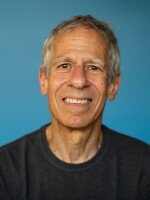Our audience members clearly want to stretch their bodies as well as their minds. A flood of e-questions floated in for stretching guru Jim Wharton after last week's Your Health segment on "active-isolated stretching." His philosophy: stretch one muscle at a time, hold the stretch two seconds, then repeat 10 times or so to improve flexibility and avoid soreness or injury from longer stretches.
And now, on to your questions (and Wharton's answers).
Q: Many listeners asked when to stretch: Before or after exercising? Or should you jog lightly for a few minutes before stretching to warm the body up?
Ideally, stretch before exercise with the "active-isolated stretching" method and after exercise as well to promote quicker and more effective recovery. If you are holding stretches for a long time, do some kind of warm up first, like an easy walk or light jog. But we would recommend you try this method of shorter stretches for at least a week. It will serve as your warm-up. And let your body be the judge. If you don't have time to stretch before and after a workout, stretch before the activity to prepare the muscle, then stretch before you go to bed at night, focusing on muscle groups that seem most tense from the day's activity.
How many repeats do you recommend for each two-second stretch? -- Jorge Quinones, Missouri City, Texas
Eight to 10 reps gives time to circulate blood and oxygen and allow the muscle to change its range gently.
Jim Wharton said a long, hard stretch is counterproductive because it brings on the myotatic or stretch reflex (Editor's note: Wharton defines the reflex as the muscle "automatically and ballistically recoil[ing] itself to protect itself from ripping"]. But we were taught in neurophysiology that only high-velocity stretching of the muscle spindle, as in bouncing, causes a reflex contraction. A static stretch shouldn't. -- Rudy Dressendorfer, Penryn, Calif.
Yes, we were all taught the same thing! But we invite you to experience the short stretches we advocate and judge for yourself. Remember, the objective is to prepare muscles prior to exercise and help them recover after activity. Muscles work in pairs. When one muscle contracts, its counterpart relaxes. Based on our research and experience, we believe that repeating two-second stretches promotes circulation and increases range of motion. We also believe that holding a stretch for a longer period does not provide these benefits and can lead to muscle soreness, irritated muscles, and possible injury.
How do you hold your back when stretching: flat (bend from the waist) or rounded? -- Debra Schwartz, St. Louis. Mo.
Allow the back to roll down naturally [in the trunk flexion exercise shown on the NPR web site]. Keeping the back flat puts unwanted pressure on the lumbar spine.
Are yoga stretches helpful? -- Andrew Sugerman, New York, N.Y.
Yoga is a comprehensive program designed for a total mind/body awareness. It was not designed as a method specifically to gain flexibility. The flexibility method we are recommending will help you attain your range of motion and achieve yoga positions with greater ease and without undue stress or potential injury.
I've read about "whole body vibration" equipment that loosens the body for better stretching. Is there any truth to that? -- Michael Stephens, Belle Mead, N.J.
We prefer the old-fashioned way of working a muscle to activate it and a complementary strength strength program, then going out and enjoying your favorite endurance activity.
Are there stretches that will aid in weight loss? -- Debra East, Lander, Wyo.
Yes. The flexibility routines are the beginning activities we recommend for weight loss. Initially, the flexibility program is a workout — and a safe way to begin preparing the muscles and joints for the more intensive exercise to come.
How should I breathe when stretching? When do I breathe in, when do I breathe out? -- Bill Tassie, Victoria, British Columbia, Can.
Exhale when you're lifting the leg, inhale on the relaxing phrase when returning the leg to the start or rest position.
Exercise physiologist Jim Wharton, a former Olympic running coach, runs a fitness clinic in New York. He is the co-author of The Whartons' Stretch Book.
Copyright 2023 NPR. To see more, visit https://www.npr.org.



